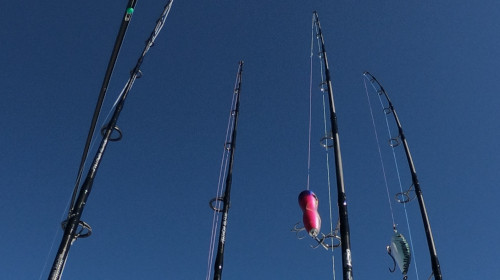Jigging & Popping Rigging Tips - Part 1: Choosing a Rod
Posted by OTI on Jun 18th 2023

At Ocean Tackle International, we understand the significance of purpose-designed jigging and popping rods, and in this blog, we delve into the features that set them apart!
When it comes to embarking on your fishing journey, your rods and reels are likely to be the most substantial investments. Many anglers initially make do with the combos they already have to ensure they enjoy the experience. However, the handle section, action, components, and blank materials of specialized rods are meticulously crafted to enhance comfort and efficiency during these dynamic fishing techniques.
At Ocean Tackle International, we are passionate about providing you with the finest specialized jigging and popping rods. Our expertly designed products prioritize performance, endurance, and angler satisfaction, ensuring you have the right tools for an unforgettable fishing experience.
What Features Distinguish a Specialized Jigging and Popping Rod?
Now that you're ready to dive into this thrilling style of fishing, let's explore the key features that distinguish specialized jigging and popping rods. Designed to reduce fatigue and enable you to endure extended rail time, these rods incorporate various elements. Firstly, a lightweight blank constructed from carbon fiber or graphite with a moderate to moderately fast action is essential. Although the shorter length may initially feel unfamiliar, you'll quickly appreciate the leverage it provides. Grips typically feature thin EVA material for enhanced comfort.
Lastly, the length of the butt section plays a crucial role. A well-designed rod should extend through your armpit, with the reel stem positioned around 17 inches from the bottom of the gimbal. In contrast, multipurpose rods usually have a butt length of 12-13 inches. The extended butt section becomes pivotal in utilizing your upper body strength for lure presentation and controlling fish, as further explained in our other articles.
Choosing the Right Rod for Your Needs
We always advise our customers to invest in the combo that aligns with their primary fishing style, which accounts for approximately 90% of their angling. For example, if you primarily target 50-80 lb yellowfin tuna in your local waters but occasionally make trips for Bluefin or GTs, we recommend purchasing a combo suited for yellowfin and considering borrowing or chartering gear for the other situations. Starting with a more versatile combo allows you to determine your personal preferences.
As you gain experience through multiple fishing trips and explore others' gear, you'll gather valuable insights on the specialized fishing products flooding the market. At this stage, you'll be ready to expand your arsenal and add lighter jigging and popping combos to your collection. Reels with additional and aftermarket spools allow you to increase line capacity on smaller frames while reducing weight and bulk. You'll soon find that these lighter combos become your favorites, offering enhanced endurance and reduced fatigue. Consider adding a light bait-catching combo and a heavier outfit for chunking/live baiting, and you'll be fully prepared for multi-day jigging and popping trips.
Choosing the Right Jigging Rod
For mechanical or speed jigging, we highly recommend a shorter rod, ideally around 5'6" to 6'0". This length allows for shorter, more efficient strokes, making it ideal for fast-moving jigs, deep jigging, and heavier jigs. A moderate action rod is preferable as it ensures the full action of the rod is transferred to the jig. The rod should load up and spring back when lifting the jig, rather than only the tip flexing, resulting in reduced movement and action. It's crucial to match the power of the rod to the jigs you commonly use to optimize performance.
In certain situations, a longer jigging rod (around 5'8" to 6'6") may be preferred. This is especially true when a longer sweeping stroke is required, or when you desire a versatile rod for live baiting, trolling, jigging, and bottom fishing. In some cases, a jigging rod can even be used to cast poppers when casting space is limited or when casting distance is not a significant concern. The leverage provided by a jigging rod in such scenarios can be advantageous.
Choosing the Right Popping Rod
The ideal length of a popping rod varies depending on your fishing circumstances, so it's essential to evaluate where and how you'll be engaging in topwater fishing. A standard starting point is a 7'6" rod, but it's worth noting that rod length doesn't always translate directly to casting distance. Factors such as blank materials, guide layout, and angler technique also play a role in determining casting distance and should be considered when choosing a rod.
If maximizing casting distance is your primary goal, our TS2 line offers excellent options. However, bear in mind that these rods are less forgiving and require careful handling. Opting for a slower action rod may slightly reduce distance but provides better shock absorption during the fight and offers improved leverage. We always plan ahead and bring the combo best suited for the specific fish species and situations we anticipate encountering during our trips.
Key factors to consider when selecting a popping rod include the proper length between the reel seat and gimbal, appropriate action in the rod blank, and the use of high-quality components. Above all, ensure that the butt section is long enough to leverage your upper body strength when working with poppers and fighting fish. This feature is crucial in reducing fatigue, extending your time on the rail, and providing optimal control when transitioning from a fighting belt.
A moderate action blank delivers a uniform, parabolic bend from the tip to the power section, allowing the tip to flex and rip the popper through the water's surface. Faster action rods result in only the tip flexing, requiring more effort to achieve the desired popper action. Finally, pay attention to the components used and their layout, as these factors greatly influence casting distance, fighting ability, and overall ergonomics.

